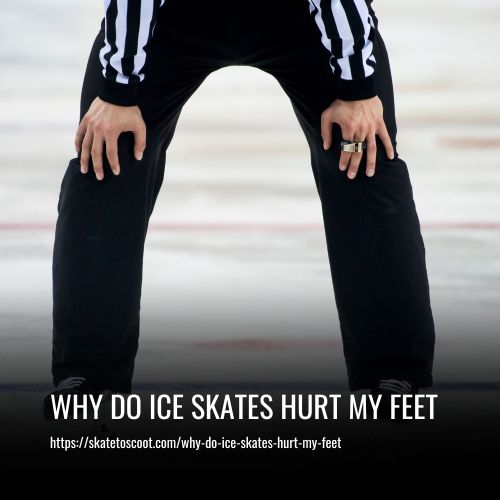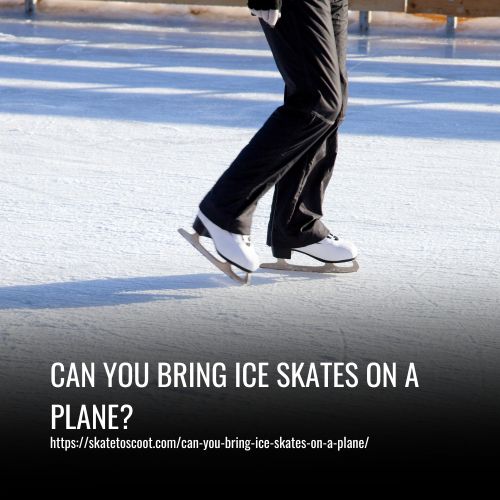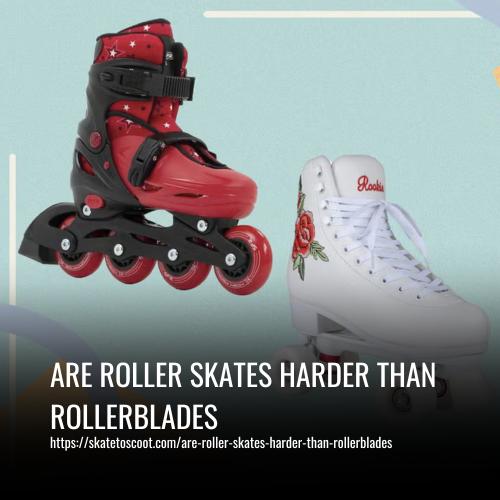As an Amazon Associate we earn from qualifying purchases.
Ice skating can be a fun activity, whether you’re gliding through an outdoor rink in winter or cruising around an indoor arena during the summer. But when your ice skates start to hurt your feet after just a few minutes, suddenly the fun stops.
The reasons why your feet hurt when you go ice skating:
- Ill-fitting Ice Skates
- Wearing the wrong socks
- Medical Condition Affecting the Ankles
- Overuse Injury from OverSkating
- Weak Foot Muscles
- Poor Ice Skating Techniques
- Fall Injuries like Broken Ankles
- Skating on Soft Ice
- Not Mopping Up After Yourself
- Walking on the Ice with Your Shoes Off
- Overuse Of Salts

The Reasons Why Ice Skates Are Hurting Your Feet
The surprising reasons why ice skates are hurting your feet.
1. Ill-fitting Ice Skates
Ill-fitting ice skates can be the source of a lot of pain, namely lace bites. This kind of pain is felt in the lower leg between the ankle joint and the end of your shins. It’s usually caused by either by laces that are too tight or skates that have become worn over time.
The progressive nature of this type of pain makes it worse each time you tie up your laces and get on the ice. That’s why it’s so important to make sure that your skates fit properly. Make sure they’re not too tight and not too loose, as both can cause lace bite pain.
2. Wearing the wrong socks
Not wearing the right gear like socks for ice skating can lead to serious discomfort. What many people don’t realize is that there can be quite a bit of friction between your feet and the ice skates during long periods of skating.
This too much rubbing can cause painful blisters on the feet unless you are using the right socks for ice skating, which are neither too thick nor too thin.
3. Medical Condition Affecting the Ankles
Pronation and supination are medical conditions that can seriously affect your ankles and feet when ice skating. Pronation is when you wear your skates and your feet bend inward, while supination is when they bend outward.
These conditions can cause extreme pain to the ankle area, making it hard to even stand let alone skate. The best way to determine if you have either of these conditions is by seeking medical advice from your doctor.
4. Overuse Injury from OverSkating
Overskating is one of the most common causes of overuse injury in ice skating. When you skate for more than what is necessary, you are likely to experience muscle soreness and pain around your ankles and feet.
While it can be tempting to skate as much as possible, it’s important to stay aware of the potential damage this can cause. Skating moderately is key – if you usually skate five hours a day, consider reducing it to three or four. This will help ensure that your body isn’t overworked and that you prevent potential injuries.
If the pain persists even after moderating your frequency of ice skating, it could be due to other causes such as inadequate skating boots or poor skating technique.
5. Weak Foot Muscles
Weak foot muscles can cause significant issues when it comes to ice skating and they need time to get used to the activity. It’s important to be patient with yourself when starting out and understand that your foot muscles need time to adjust or become accustomed to the rigors of ice skating.
Once you’ve put in four to six weeks of consistent skating, your foot muscles should be more comfortable with the sport, so it’s important to keep practicing.
6. Poor Ice Skating Techniques
Poor ice skating techniques can be the real culprit when it comes to pain in the feet. When the incorrect posture is used, there is too much pressure concentrated in one area, often around the ankles and ankle joints. In order to prevent this, it’s important to make sure you are using the right techniques when ice skating.
The correct posture involves bending low with knees above your toes and shoulders over hips, which will help shift your body weight onto your toe balls and away from the ankles. Doing so will help ensure that you have a more enjoyable time on the ice while also keeping your feet healthy.
7. Fall Injuries like Broken Ankles
When learning how to ice skate, it is normal to slip and fall since it can be challenging to stay balanced on the icy surface. Inevitably, you’ll fall from time to time and that can result in serious injuries like broken ankles.
While the pain may not be immediate, as you skate more often, the discomfort will become increasingly apparent.
8. Skating on Soft Ice
Skating on soft ice can be a tricky situation. Skating on an ice rink created from polyurethane will cause it to slowly melt over time. When the ice becomes too soft and begins to give way, it won’t be able to support your weight—this can make skating difficult and potentially dangerous.
Whenever you’re skating on softer surfaces, be sure to stay light on your feet and use caution while attempting jumps or turns.
9. Not Mopping Up After Yourself
Not mopping up after yourself after your session on the ice is one of the most important things you need to do in order to protect your feet from blisters and other injuries.
The best way to clean is with warm water and soap – never use ice or salt scrubbers, as this will just make the surface more moist.
Furthermore, be aware of any wet surfaces or areas around doors or steps which could lend themselves to bacterial growth – clean these quickly and thoroughly.
10. Walking on the Ice with Your Shoes Off
Walking on the ice with your shoes off can be risky and extremely painful. This is because barefoot provides more friction against the surface, easily leading to blisters and inflammation in your feet. Therefore, it’s important to take safety measures when going ice skating.
11. Overuse Of Salts
Ice skaters need to be aware of the dangers of overusing salts when on the ice. When salt is used on the ice, it makes it harder and more durable – but this can cause blisters, callouses, and other foot problems if not managed correctly.
Overuse of salts on the rink can result in feet becoming calloused, which can make skating either difficult or painful.
How Do I Stop My Feet From Hurting When Ice Skating
To stop suffering from foot pain while ice skating, take measures to prevent it from happening again.
1. Wearing The Correct Sock Size
Having the proper size socks is essential to ensure your feet are comfortable while ice skating. You want socks that fit snugly, so they won’t move around while you’re putting your best spin moves out on the ice, but you also don’t want them too tight which could restrict your blood flow.
| Size | Bauer Skate Size |
| X-Small | 10 – 1.5 Youth |
| Small | 2 – 4.5 Junior |
| Medium | 5 – 7 Senior |
| Large | 7.5 – 10 Senior |
| X-Large | 10.5 – 13 Senior |
2. Skating in Light Boots
Skating in light boots is an excellent option if you need to stop your feet from hurting while ice skating. Make sure to adjust the fit of the boots accordingly – they should fit snugly around your feet without being too tight or restrictive.
Remember that shoes and socks will stretch after long periods of skating, which can cause discomfort while walking or standing. As such, it’s important to adjust your boots before each skate session so that they provide a secure but comfortable fit for your feet during your skating adventures.
3. Adjusting Your Boot Fit
If you’re experiencing discomfort while ice skating, it can be a sign that your boots don’t fit properly. In order to make sure you get the best fit and maximum comfort, you may need to adjust the straps at the ankle joints or slide one foot inside each shoe on the blade guard railings.
Doing this should only be done if you are feeling significant pain with your current setup. If it doesn’t help alleviate any pain then make sure to book an appointment with a professional skate technician as soon as possible, instead of trying to fix it yourself.
Not getting a proper boot fit could have expensive consequences down the line, so make sure you take all necessary steps in order to ensure maximum comfort and durability when ice skating.
Is It Normal for Skates to Hurt Your Feet
Yes, it is normal for ice skates to hurt your feet when you start out skating! This is because the process of learning how to skate involves a lot of muscles and bones getting used in new ways, which can cause discomfort until you get used to the motion.
Finding the right pair of skates is essential if you want to reduce the amount of pain while skating. Skate shoes should offer excellent support and maneuverability for your feet.
They should also be fitted with gel as this helps increase friction between your foot and the ice surface and makes it easier for you to stay on your skates.
FAQs
Ice skates should be snug, not too tight, and not too loose. Leave about a ½ inch of space around your feet for comfortable movement.
Incorrect skating techniques and not having the proper apparel, such as socks and properly fitting skates, can lead to foot problems from ice skating.
To avoid discomfort when ice skating, use properly fitting shoes, wear two pairs of socks, don’t overstate, and do foot and ankle exercises to strengthen weak muscles.
To ensure comfortable ice skating, make sure to lace and tie your skates just below the highest hooks. Wearing a new pair of skates for the first time is a good way to break them in and reduce pressure on your feet.
Conclusion
In conclusion, there are many reasons why ice skates can cause pain and discomfort while skating. To avoid sore feet, make sure to get fitted correctly and wear the right size of boots. It is also important to break in your new skates with proper stretching exercises before attempting any skillful maneuvers.
In addition, keeping your skates clean and well maintained can reduce any potential issues that may arise in the future.
Amazon and the Amazon logo are trademarks of Amazon.com, Inc, or its affiliates.


